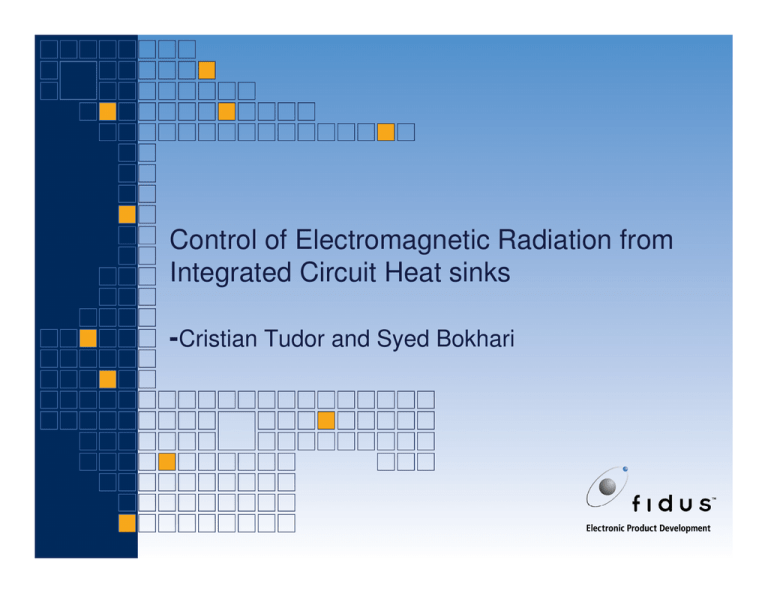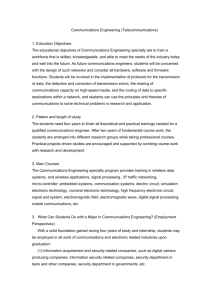Control of Electromagnetic Radiation from Integrated Circuit Heat sinks
advertisement

Control of Electromagnetic Radiation from Integrated Circuit Heat sinks -Cristian Tudor and Syed Bokhari Problem of Heat Sink radiation • Indirect radiation (near field) •Concentration of high speed signals on IC periphery •Area in the periphery of heat sink is prime real estate Slide 2 DesignCon 2009: Control of Electromagnetic Radiation from Integrated Circuit Heat sinks - Cristian Tudor & S. Bokhari Methods for Control 1. Optimize heat sink geometry • 10+ dB suppression possible • Limited freedom and is Frequency selective 2. Absorber material surrounding heat sink • Significant broad band suppression possible • Consumes large area around heatsink 3. Multi-point grounding • 10+ dB suppression possible • Frequency selective • More suppresion requires more grounds Slide 3 DesignCon 2009: Control of Electromagnetic Radiation from Integrated Circuit Heat sinks - Cristian Tudor & S. Bokhari Resistive loading Slide 4 DesignCon 2009: Control of Electromagnetic Radiation from Integrated Circuit Heat sinks - Cristian Tudor & S. Bokhari 2D Model Approximation and analysis Slide 5 DesignCon 2009: Control of Electromagnetic Radiation from Integrated Circuit Heat sinks - Cristian Tudor & S. Bokhari Impedance and Near field radiation – 2D model without fins Slide 6 DesignCon 2009: Control of Electromagnetic Radiation from Integrated Circuit Heat sinks - Cristian Tudor & S. Bokhari 2D Model with fins Slide 7 DesignCon 2009: Control of Electromagnetic Radiation from Integrated Circuit Heat sinks - Cristian Tudor & S. Bokhari Impedance and Near field radiation – 2D model with fins Slide 8 DesignCon 2009: Control of Electromagnetic Radiation from Integrated Circuit Heat sinks - Cristian Tudor & S. Bokhari Heat sink Excitation Model and IC encapsulation • • • Slide 9 Small square loop with a 1 V delta gap voltage source Located between ground plane and Heat sink bottom Loop center offset from origin (2 mm,2mm,2mm) DesignCon 2009: Control of Electromagnetic Radiation from Integrated Circuit Heat sinks - Cristian Tudor & S. Bokhari Peak Radiation from Excitation alone 0 Reference Max Near Etotal (dB) -10 -20 -30 -40 -50 1 2 3 4 5 6 Frequency (GHz) Slide 10 DesignCon 2009: Control of Electromagnetic Radiation from Integrated Circuit Heat sinks - Cristian Tudor & S. Bokhari Bi-directional Heatsink with a low fin density Slide 11 DesignCon 2009: Control of Electromagnetic Radiation from Integrated Circuit Heat sinks - Cristian Tudor & S. Bokhari Peak Near field without Resistive loading 0 Reference Ungrounded Max Near Etotal (dB) -10 4 Grounds -20 -30 -40 -50 1 2 3 4 5 6 Frequency (GHz) Slide 12 DesignCon 2009: Control of Electromagnetic Radiation from Integrated Circuit Heat sinks - Cristian Tudor & S. Bokhari Peak Near field with Resistive loading -10 4 Grounds 5 Ohms 25 Ohms -20 50 Ohms Max Near Etotal (dB) 75 Ohms 100 Ohms -30 -40 -50 1 2 3 4 5 6 Frequency (GHz) Slide 13 DesignCon 2009: Control of Electromagnetic Radiation from Integrated Circuit Heat sinks - Cristian Tudor & S. Bokhari Bi-directional Heatsink with a high fin density Slide 14 DesignCon 2009: Control of Electromagnetic Radiation from Integrated Circuit Heat sinks - Cristian Tudor & S. Bokhari Peak Near field with and without Resistive loading 10 Max Near Etotal (dB) 0 4 Grounds 50 Ohms -10 -20 -30 -40 -50 1 1.5 2 2.5 3 3.5 4 4.5 5 5.5 6 Frequency (GHz) Slide 15 DesignCon 2009: Control of Electromagnetic Radiation from Integrated Circuit Heat sinks - Cristian Tudor & S. Bokhari Magnitude of surface current distribution of ungrounded heatsink (2.3 GHz) Slide 16 DesignCon 2009: Control of Electromagnetic Radiation from Integrated Circuit Heat sinks - Cristian Tudor & S. Bokhari Magnitude of surface current distribution of grounded heatsink (3 GHz) Slide 17 DesignCon 2009: Control of Electromagnetic Radiation from Integrated Circuit Heat sinks - Cristian Tudor & S. Bokhari Effect of shunt capacitance of resistors -10 0 pF 2 pF -20 Max Near Etotal (dB) 1pF 0.5 pF -30 -40 -50 1 1.5 2 2.5 3 3.5 4 4.5 5 5.5 6 Frequency (GHz) Slide 18 DesignCon 2009: Control of Electromagnetic Radiation from Integrated Circuit Heat sinks - Cristian Tudor & S. Bokhari Omnidirectional Heat sink Slide 19 DesignCon 2009: Control of Electromagnetic Radiation from Integrated Circuit Heat sinks - Cristian Tudor & S. Bokhari Peak Near field without Resistive loading 10 Reference Ungrounded Max Near Etotal (dB) 0 4 Grounds -10 -20 -30 -40 1 2 3 4 5 6 Fre quency (GHz) Slide 20 DesignCon 2009: Control of Electromagnetic Radiation from Integrated Circuit Heat sinks - Cristian Tudor & S. Bokhari Peak Near field with Resistive loading 10 4 Grounds 0 2.5 Ohms Max Near Etotal (dB) 10 Ohms 25 Ohms -10 50 Ohms -20 -30 -40 -50 1 2 3 4 5 6 Frequency (GHz) Slide 21 DesignCon 2009: Control of Electromagnetic Radiation from Integrated Circuit Heat sinks - Cristian Tudor & S. Bokhari Magnitude of surface current distribution of grounded omnidirectional heatsink(4 GHz) Slide 22 DesignCon 2009: Control of Electromagnetic Radiation from Integrated Circuit Heat sinks - Cristian Tudor & S. Bokhari Omni-directional heatsink with wide fins Slide 23 DesignCon 2009: Control of Electromagnetic Radiation from Integrated Circuit Heat sinks - Cristian Tudor & S. Bokhari Peak Near field with and without Resistive loading 0 4 Grounds 50 Ohms Max Near Etotal (dB) -10 -20 -30 -40 -50 1 2 3 4 5 Frequency (GHz) Slide 24 DesignCon 2009: Control of Electromagnetic Radiation from Integrated Circuit Heat sinks - Cristian Tudor & S. Bokhari 6 Conclusion 1. Actual heat sink geometry must be simulated to determine type of resonance 2. Microstrip cavity type resonances can be suppresed with resistive loading 3. Optimum resistance values are in the range of 50 Ω 4. Resistors of low shunt parasitic capacitance are required 5. Where heat dissipation requirements are met with a bi-directional heat sink, do not use Omni-directional heat sinks Slide 25 DesignCon 2009: Control of Electromagnetic Radiation from Integrated Circuit Heat sinks - Cristian Tudor & S. Bokhari Authors’ Biographies Cristian is currently a senior signal integrity engineer with Fidus Systems, Ottawa. His work includes analog simulations of high speed interfaces, interconnect modeling, characterization and optimization. He is also engaged in the design and characterization of power distribution networks, SSO analysis, jitter analysis both at board as well as microcircuit level. Prior to joining Fidus, Cristian was part of the engineering staff at Nortel Networks and Chipworks Inc. He was involved in signal integrity and patent analysis related to integrated circuits. Cristian holds a M.Sc diploma in Electrical Engineering from the Polytechnic University, Bucharest, Romania. Cristian Tudor, cristian.tudor@fidus.com Tel: 1.613-828-0063 Ext: 382 Syed Bokhari received a Ph.D degree in Electrical Engineering from the Indian Institute of Science, Bangalore, India. He is currently a Lead Signal Integrity and EMC specialist at Fidus Systems inc. He has over 20 years experience, primarily in the area of electromagnetic modeling. His previous academic employers include Ecole Polytechnic Federale de Lausanne in Switzerland, and the university of Ottawa in Canada. He has worked in the industry at the Indian Space Research Organization, and at Cadence Design Systems (Canada) Ltd. He has over 50 publications, contributed to chapters in books and holds one patent. He is a senior member of the IEEE and is the chairman of the Ottawa EMC chapter. His areas of current interest include interconnect modeling for SI and EMC, and RFID antenna design. Syed Bokhari, syed.bokari@fidus.com Tel: 1.613-828-0063 Ext: 377 Slide 26 DesignCon 2009: Control of Electromagnetic Radiation from Integrated Circuit Heat sinks - Cristian Tudor & S. Bokhari Contact Information Fidus Systems Headquarters 900 Morrison Drive, Suite 203 Ottawa, ON K2H 8K7 Canada 1-866-88-FIDUS (34387) info@fidus.com www.fidus.com Slide 27 Fidus California Design Centre 2900 Lakeside Drive, Suite 225 Santa Clara, CA, 95054 USA 1-408-307-4562 mike.shamshirian@fidus.com DesignCon 2009: Control of Electromagnetic Radiation from Integrated Circuit Heat sinks - Cristian Tudor & S. Bokhari




